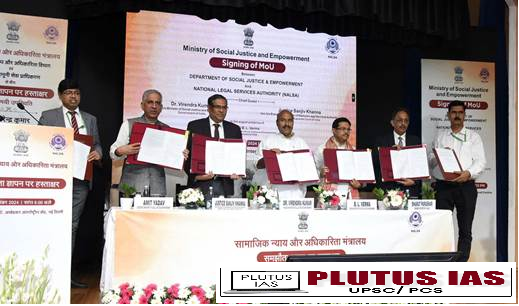Department of Social Justice & Empowerment:
The Department of Social Justice & Empowerment is a governmental body responsible for formulating and implementing policies and programs aimed at promoting social justice, equality, and empowerment of disadvantaged groups. This includes:
1.Welfare Schemes: Developing and executing various social welfare initiatives targeting Scheduled Castes, Scheduled Tribes, women, children, and persons with disabilities.
2.Capacity Building: Enhancing the skills and capabilities of marginalized groups to ensure their active participation in society.
3.Advocacy: Promoting awareness about rights and entitlements among vulnerable populations.
National Legal Services Authority (NALSA)
The National Legal Services Authority (NALSA) is an autonomous body established under the Legal Services Authorities Act, 1987. It operates under the Ministry of Law and Justice, Government of India, with the primary aim of providing free legal services to the marginalized and disadvantaged sections of society.
1.Legal Aid: Ensuring access to justice for economically and socially disadvantaged individuals through free legal services.
2.Awareness Programs: Educating the public about their legal rights and available legal aid services.
3.Coordination: Working with state legal services authorities, NGOs, and other stakeholders to implement legal aid programs effectively.
Functions of NALSA:
1.Establish Legal Aid Clinics: Set up legal aid clinics to provide legal assistance and advice to those in need.
2.Conduct Awareness Programs: Organize workshops, seminars, and campaigns to educate people about their legal rights and the services available to them.
3.Coordination with State Authorities: Collaborate with State Legal Services Authorities (SLSAs) to implement legal aid programs effectively at the state level.
4.Monitoring and Evaluation: Assess the effectiveness of legal aid services and ensure that they reach the intended beneficiaries.
Government Initiatives Complementing the MoU:
1.Legal Services Authorities Act, 1987: Provides the framework for legal aid services in India, ensuring free legal assistance to eligible individuals.
2.Social Welfare Schemes: Various government schemes target SC/ST communities, women, children, and persons with disabilities, enhancing their access to services.
3.National Policy for the Empowerment of Women: Aims to eliminate discrimination against women and enhance their legal rights.
4.Rights of Persons with Disabilities Act, 2016: Ensures that persons with disabilities have access to justice and legal support.
Target Beneficiaries:
1.Scheduled Castes and Scheduled Tribes: Special focus on empowering these communities, which often face systemic discrimination.
2.Women and Children: Addressing the specific vulnerabilities faced by women and children in legal contexts.
3.Persons with Disabilities: Ensuring their rights are protected and that they have access to legal recourse.
Expected Outcomes
4.Improved Access to Justice: Increased awareness and access to legal aid will lead to more individuals seeking justice.
5.Enhanced Legal Literacy: Communities will become more informed about their rights and the legal processes available to them.
6.Strengthened Social Cohesion: By promoting justice and equality, the initiative is expected to foster a sense of community and belonging among diverse groups.
7.Informed Policy Making: Research findings will inform future policies and initiatives, ensuring they are targeted and effective.
Challenges:
1.Awareness and Accessibility: Many marginalized communities may not be aware of their rights or the available social welfare schemes. Limited outreach efforts can lead to underutilization of these programs.
2.Complexity of Schemes: The intricate nature of various welfare schemes can confuse beneficiaries, making it difficult for them to understand eligibility criteria and application processes.
3.Resource Limitations: Financial constraints and lack of personnel can hinder the effective implementation of awareness campaigns and training programs.
4.Technological Barriers: In rural and underserved areas, limited access to technology and the internet can impede the dissemination of information and resources.
5.Coordination Among Stakeholders: Ensuring effective collaboration between different government departments, NGOs, and community organizations can be challenging, leading to fragmented efforts.
Way Forward
1.Enhanced Outreach Programs: Develop targeted awareness campaigns utilizing both traditional and digital media to reach diverse communities effectively.
2.Simplification of Information: Create easy-to-understand materials and guides that break down the complexities of welfare schemes, using local languages and culturally relevant examples.
3.Utilization of Technology: Leverage mobile apps and online platforms for real-time information sharing, allowing beneficiaries to access services and updates easily.
4.Community Engagement: Involve local leaders and community organizations in the design and execution of programs to ensure they meet specific local needs.
5.Training and Capacity Building: Conduct regular training sessions for government officials, NGOs, and community workers to enhance their understanding of welfare schemes and improve their ability to assist beneficiaries.
Conclusion:
The MoU between the Department of Social Justice & Empowerment and NALSA represents a crucial initiative to empower marginalized communities through increased awareness of social welfare schemes. By addressing the identified challenges and implementing a strategic way forward, the partnership has the potential to create a more informed and equitable society. Successful execution will depend on collaboration, resource mobilization, and a commitment to continuous engagement with communities, ultimately ensuring that the benefits of social welfare programs reach those who need them the most.






No Comments